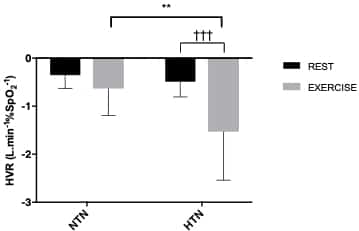Hypertension is the main risk factor contributing to burden of disease globally (1). At rest, hypertensive humans (HTN) demonstrate increased carotid body (CB) chemosensitivity compared to normotensive (NTN) controls, revealed by a raised Hypoxic Ventilatory Response (HVR (2). HTN also show an exaggerated Blood Pressure (BP) response during exercise (exercise pressor response; EPR; (3)). The CB’s play a role in the EPR in hypertensive rats (4) but their role in the EPR of humans is unknown. This study aimed to examine HVR during exercise in HTN compared to NTN & whether CB blockade with dopamine can blunt EPR in HTN. 8 NTN (2 women) & 12 HTN (5 women) participants completed a 25W.min-1, ramped upright cycle ergometer exercise test to obtain peak oxygen consumption (VO2peak). HVR was assessed at rest & during moderate exercise (≈45% VO2peak) using a transient, poikilocapnic technique with titration of nitrogen to inspired air to achieve oxygen saturations (SpO2) of 87% for 2-3min. HVR was calculated by linear regression of the change in minute ventilation (VE) divided by the change in SpO2 during hypoxia (5). CB Blockade was assessed during exercise by comparison of BP during intravenous infusion of 2mcg.kg-1min-1 of dopamine with an infusion of 0.9% saline as a vehicle control. Unpaired T tests compared demographic data while HVR & CB blockade data were compared by 2-way ANOVAS with repeated measures. Alpha was set at P<0.05. Data are mean±SD. There was no difference between groups in age (NTN: 61±8 vs HTN: 65.3±7.6yrs; P=0.2429), Body Mass Index (BMI) (NTN: 25.6±3.7 vs HTN: 26±4kg.m-2; P=0.7923), VO2peak (NTN: 24.6±12 vs HTN: 23.1±9mL.min-1.kg-1; P=0.7722) or level of exercise used to assess HVR & CB blockade (NTN: 43.8±14.5 vs HTN: 47.3±17.9%VO2peak; P=0.6709). At rest, HVR did not differ between groups (NTN: -0.4±0.3 vs HTN: -0.6±0.6L.min-1.%SpO2-1; P=0.8716). During moderate exercise, HVR remained unchanged from rest in NTN (-0.5±0.3 1L.min-1.%SpO2-1; P=0.5725) but increased by 58.8% in HTN (-1.5±1L.min-1.%SpO2-1; P=0.0007). HVR was also significantly higher in HTN than NTN during exercise (P=0.0086, Figure 1). CB blockade (dopamine vs saline) during exercise did not alter systolic BP (SBP), mean arterial pressure (MAP) or diastolic BP (DBP) in NTN (SBP: 127.2±11.2 vs 130.8±15.4mmHg; P=0.7942; MAP: 91.7±9.3 vs 91.2±9.9mmHg; P=0.9882; DBP: 73.6±11.4 vs 71.4±8.1mmHg; P=0.7733) but significantly reduced MAP & DBP in HTN (SBP: 143.2 vs 131.5mmHg; P=0.0637; MAP: 101.1±17.3 vs 95.3±13.6 mmHg; P=0.0076; DBP: 86.0±7.5 vs 77.0±16.4mmHg; P=0.0124). These data indicate that HVR is elevated in middle-aged hypertensives during moderate exercise and that the CB’s could play a role in the exaggerated pressor response to exercise in people with hypertension, which has been shown to be associated with worse outcomes but is not normalised by current antihypertensive drugs.
Physiology 2019 (Aberdeen, UK) (2019) Proc Physiol Soc 43, C010
Oral Communications: Carotid body chemosensitivity is enhanced during moderate exercise in human hypertension
K. A. Hope3, L. Ratcliffe4, A. Burchell1, T. Hinton1,3, B. Chant3, A. Nightingale1,3, J. F. Paton2, E. C. Hart3
1. Bristol Heart Institute, University Hospitals Bristol NHS Foundation Trust, Bristol, BS2 8HW, United Kingdom. 2. Department of Physiology, Faculty of Medical & Health Sciences, University of Auckland, Auckland, New Zealand. 3. School of Physiology, Pharmacology & Neuroscience, University of Bristol, Bristol, United Kingdom. 4. Department of Nephrology, Lister Hospital, East & North Herfordshire NHS trust, Stevenage, United Kingdom.
View other abstracts by:
Figure 1. Carotid Body (CB) chemosensitivity as measured by Hypoxic Ventilatory Response (HVR) in Normotensive (NTN) and Hypertensive (HTN) humans at rest and during exercise. Values are mean±SD. **P<0.01 NTN vs HTN during exercise, †P<0.001 HTN rest vs exercise.
Where applicable, experiments conform with Society ethical requirements.

